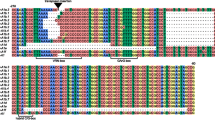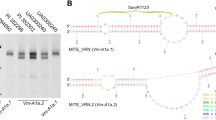Abstract
The broad adaptability of wheat and barley is in part attributable to their flexible growth habit, in that spring forms have recurrently evolved from the ancestral winter growth habit. In diploid wheat and barley growth habit is determined by allelic variation at the VRN-1 and/or VRN-2 loci, whereas in the polyploid wheat species it is determined primarily by allelic variation at VRN-1. Dominant Vrn-A1 alleles for spring growth habit are frequently associated with mutations in the promoter region in diploid wheat and in the A genome of common wheat. However, several dominant Vrn-A1, Vrn-B1, Vrn-D1 (common wheat) and Vrn-H1 (barley) alleles show no polymorphisms in the promoter region relative to their respective recessive alleles. In this study, we sequenced the complete VRN-1 gene from these accessions and found that all of them have large deletions within the first intron, which overlap in a 4-kb region. Furthermore, a 2.8-kb segment within the 4-kb region showed high sequence conservation among the different recessive alleles. PCR markers for these deletions showed that similar deletions were present in all the accessions with known Vrn-B1 and Vrn-D1 alleles, and in 51 hexaploid spring wheat accessions previously shown to have no polymorphisms in the VRN-A1 promoter region. Twenty-four tetraploid wheat accessions had a similar deletion in VRN-A1 intron 1. We hypothesize that the 2.8-kb conserved region includes regulatory elements important for the vernalization requirement. Epistatic interactions between VRN-H2 and the VRN-H1 allele with the intron 1 deletion suggest that the deleted region may include a recognition site for the flowering repression mediated by the product of the VRN-H2 gene of barley.



Similar content being viewed by others
References
Barrett B, Bayram M, Kidwell K (2002) Identifying AFLP and microsatellite markers for vernalization response gene Vrn-B1 in hexaploid wheat (Triticum aestivum L.) using reciprocal mapping populations. Plant Breed 121:400–406
Bastow R, Mylne JS, Lister C, Lippman Z, Martienssen RA, Dean C (2004) Vernalization requires epigenetic silencing of FLC by histone methylation. Nature 427:164–167
Busch MA, Bomblies K, Weigel D (1999) Activation of a floral homeotic gene in Arabidopsis. Science 285:585–587
Cenci A, Chantret N, Xy K, Gu Y, Anderson OD, Fahima T, Distelfeld A, Dubcovsky J (2003) Construction and characterization of a half million clones Bacterial Artificial Chromosome (BAC) library of durum wheat. Theor Appl Genet 107:931–939
Chen C-L (2002) Molecular characterization of the Vrn-H2 locus in barley. MS Thesis. Department of Agronomy and Range Science, University of California, Davis
Chouard P (1960) Vernalization and its relations to dormancy. Annu Rev Plant Physiol 11:191–238
Danyluk J, Kane NA, Breton G, Limin AE, Fowler DB, Sarhan F (2003) TaVRT-1, a putative transcription factor associated with vegetative to reproductive transition in cereals. Plant Physiol 132:1849–1860
Deyholos MK, Sieburth LE (2000) Separable whorl-specific expression and negative regulation by enhancer elements within the AGAMOUS second intron. Plant Cell 12:1799–1810
Dubcovsky J, Yan L (2003) Allelic variation in the promoter of Ap1, the candidate gene for Vrn-1. In: Pogna N (ed) Proceedings of the 10th international wheat genetics symposium, vol 1. Paestum, Italy, pp 243–246
Dubcovsky J, Galvez AF, Dvorak J (1994) Comparison of the genetic organization of the early salt stress response gene system in salt-tolerant Lophopyrum elongatum and salt-sensitive wheat. Theor Appl Genet 87:957–964
Fiume E, Christou P, Gianí S, Breviario D (2004) Introns are key regulatory elements of rice tubulin expression. Planta 218:693–703
Gazzani S, Gendall AR, Lister C, Dean C (2003) Analysis of the molecular basis of flowering time variation in Arabidopsis accessions. Plant Physiol 132:1107–1114
Halloran GM (1967) Gene dosage and vernalization response in homoeologous group 5 of Triticum aestivum. Genetics 57:401–407
Hayes PM, Chen FQ, Corey A, Pan A, Chen THH, Baird E, Powell W, Thomas W, Waugh R, Bedo Z, Karsai I, Blake T, Oberthur L (1997) The Dicktoo × Morex population: a model for dissecting components of winterhardiness in barley. In: Li PH, Chen THH (eds) Plant cold hardiness. Plenum Press, New York, pp 77–87
He Y, Michaels SD, Amasino RM (2003) Regulation of flowering time by histone acetylation in Arabidopsis. Science 302:1751–1754
Jack T (2004) Molecular and genetic mechanisms of floral control. Plant Cell 16:S1–S17
Kapranov P, Routt SM, Bankaitis VA, de Bruijn FJ, Szczyglowski K (2001) Nodule-specific regulation of phosphatidylinositol transfer protein expression in Lotus japonicus. Plant Cell 13:1369–1382
Karsai I, Hayes PM, Kling J, Matus IA, Meszaros K, Lang L, Bedo Z, Sato K (2004) Genetic variation in component traits of heading date in Hordeum vulgare subsp. spontaneum accessions characterized in controlled environments. Crop Sci 44:1622–1632
Kato K, Yamagata H (1988) Method for evaluation of chilling requirement and narrow-sense earliness of wheat cultivars. Jpn J Breed 38:172–186
Maystrenko OL (1974) Identification of chromosomes carrying genes Vrn1 and Vrn3 inhibiting winter habit in wheat. Eur Wheat Aneuploid Co-Op Newslett 4:49–52
McIntosh RA, Yamazaki Y, Devos KM, Dubcovsky J, Rogers WJ, Appels R (2003) Catalogue of gene symbols for wheat. In: Pogna NE, Romano M, Pogna E, Galterio G (eds) Proceedings of the 10th international wheat genetics symposium. Instituto Sperimentale per la Cerealicoltura, Rome, Paestum, Italy (http://wheat.pw.usda.gov/ggpages/wgc/2000upd.html.)
Michaels SD, Amasino RM (1999) Flowering locus C encodes a novel MADS domain protein that acts as a repressor of flowering. Plant Cell 11:949–956
Michaels SD, He Y, Scortecci KC, Amasino RM (2003) Attenuation of FLOWERING LOCUS C activity as a mechanism for the evolution of summer-annual flowering behavior in Arabidopsis. Proc Natl Acad Sci USA 100:10102–10107
Murai K, Murai R, Takumi S, Ogihara Y (1998) cDNA cloning of three MADS box genes in wheat (Accession Nos. AB007504, AB007505 and AB007506). Plant Physiol 118:330
Pugsley AT (1971) A genetic analysis of the spring–winter habit of growth in wheat. Aust J Agric Res 22:21–31
Pugsley AT (1972) Additional genes inhibiting winter habit in wheat. Euphytica 21:547–552
Ramakrishna W, Dubcovsky J, Park YJ, Busso CS, Emberton J, SanMiguel P, Bennetzen JL (2002) Different types and rates of genome evolution detected by comparative sequence analysis of orthologous segments from four cereal genomes. Genetics 162:1389–1400
Rozen S, Skaletsky HJ (2000) Primer3 on the WWW for general users and for biologist programmers. In: Krawetz S, Misener S (eds) Bioinformatics methods and protocols: methods in molecular biology. Humana Press, Totowa NJ, pp 365–386
Schmitz J, Franzen R, Ngyuen TH, Garcia-Maroto F, Pozzi C, Salamini F, Rohde W (2000) Cloning, mapping and expression analysis of barley MADS-box genes. Plant Mol Biol 42:899–913
Sears ER (1966) Nullisomic-tetrasomic combinations in hexaploid wheat. In: Rilly R, Lewis KR (eds) Chromosome manipulations and plant genetics. Oliver and Boyd, Edinburgh, pp 29–45
Sheldon CC, Burn JE, Perez PP, Metzger J, Edwards JA, Peacock WJ, Dennis ES (1999) The FLF MADS box gene: a repressor of flowering in Arabidopsis regulated by vernalization and methylation. Plant Cell 11:445–458
Sheldon CC, Conn AB, Dennis ES, Peacock WJ (2002) Different regulatory regions are required for the vernalization-induced repression of FLOWERING LOCUS C and for the epigenetic maintenance of repression. Plant Cell 14:2527–2537
Stelmakh AF (1993) Genetic effects of Vrn genes on heading date and agronomic traits in bread wheat. Euphytica 65:53–60
Stelmakh AF (1998) Genetic systems regulating flowering response in wheat. Euphytica 100:359–369
Takahashi R, Yasuda S (1971) Genetics of earliness and growth habit in barley. In: Nilan RA (ed) Proceedings of the 2nd international barley genetics symposium. Washington State University Press, Pullman, pp 388–408
Tranquilli GE, Dubcovsky J (2000) Epistatic interactions between vernalization genes VRN-Am1 and Vrn-Am2 in diploid wheat. J Hered 91:304–306
Trevaskis B, Bagnall DJ, Ellis MH, Peacock WJ, Dennis ES (2003) MADS-box genes control vernalization-induced flowering in cereals. Proc Natl Acad Sci USA 100:13099–13104
Wang HY, Lee MM, Schiefelbein JW (2002) Regulation of the cell expansion gene RHD3 during Arabidopsis development. Plant Physiol 129:638–649
Wolfe RI, Franckowiak JD (1991) Multiple dominant and recessive genetic marker stocks in spring barley. Barley Genet Newslett 20:117–121
Xu Z, Deal KR, Li W, Covaleda L, Chang YL, Dvorak J, Luo M-C, Gill BS, Anderson OD, Zhang HB (2002) Construction and characterization of five large-insert BAC and BIBAC libraries of Aegilops tauschii, the diploid donor of the wheat D genome. Plant, animal, and microbe genomes X conference, San Diego (available at http://www.intl-pag.org/pag/10/abstracts/PAGX_P92.html: P92)
Yan L, Loukoianov A, Tranquilli G, Helguera M, Fahima T, Dubcovsky J (2003) Positional cloning of wheat vernalization gene VRN1. Proc Natl Acad Sci USA 100:6263–6268
Yan L, Helguera M, Kato K, Fukuyama S, Sherman J, Dubcovsky J (2004a) Allelic variation at the VRN-1 promoter region in polyploid wheat. Theor Appl Genet 109:1677--1686
Yan L, Loukoianov A, Blechl A, Tranquilli G, Ramakrishna W, SanMiguel P, Bennetzen JL, Echenique V, Dubcovsky J (2004b) The wheat VRN2 gene is a flowering repressor down-regulated by vernalization. Science 303:1640–1644
Yu Y, Tomkins JP, Waugh R, Frisch DA, Kudrna D, Kleinhofs A, Brueggeman RS, Muehlbauer GJ, Wise RP, Wing RA (2000) A bacterial artificial chromosome library for barley (Hordeum vulgare L.) and the identification of clones containing putative resistance genes. Theor Appl Genet 101:1093–1099
Yutzey KE, Kline RL, Konieczny SF (1989) An internal regulatory element controls troponin I gene expression. Mol Cell Biol 9:1397–1405
Acknowledgements
The authors thank Mignon Dunbar and Lenka Valarikova for excellent technical assistance, Dr. H. Bockelman and the National Small Grain Collection for the wheat and barley germplasm, Xiaoqin Zhang for the Langdon × Durelle Vrn-A1 mapping population, Dr. Kim Kidwell for the Triple Dirk seeds and the VRN-B1 mapping population and A. Kleinhofs for the barley mapping population. In the Dubcovsky laboratory, this research was supported by the United States Department of Agriculture CSREES NRI competitive grant 2003–00929 and IFAFS competitive grant 2001–04462. In the Hayes laboratory, this research was supported by the National Science Foundation Project No. DBI0110124 and the North American Barley Genome Project. In the EEA INTA Marcos Juárez Argentina, this research was supported by the INTA National Project No. 52522101. The work has been carried out in compliance with the current laws governing genetic experimentation in the USA
Author information
Authors and Affiliations
Additional information
Communicated by W.R. McCombie
An erratum to this article is available at http://dx.doi.org/10.1007/s00438-005-0045-0.
Rights and permissions
About this article
Cite this article
Fu, D., Szűcs, P., Yan, L. et al. Large deletions within the first intron in VRN-1 are associated with spring growth habit in barley and wheat. Mol Genet Genomics 273, 54–65 (2005). https://doi.org/10.1007/s00438-004-1095-4
Received:
Accepted:
Published:
Issue Date:
DOI: https://doi.org/10.1007/s00438-004-1095-4




